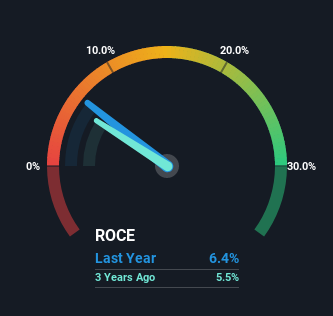- Hong Kong
- /
- Commercial Services
- /
- SEHK:1397
Some Investors May Be Worried About Baguio Green Group's (HKG:1397) Returns On Capital
To find a multi-bagger stock, what are the underlying trends we should look for in a business? Amongst other things, we'll want to see two things; firstly, a growing return on capital employed (ROCE) and secondly, an expansion in the company's amount of capital employed. This shows us that it's a compounding machine, able to continually reinvest its earnings back into the business and generate higher returns. In light of that, when we looked at Baguio Green Group (HKG:1397) and its ROCE trend, we weren't exactly thrilled.
What Is Return On Capital Employed (ROCE)?
For those that aren't sure what ROCE is, it measures the amount of pre-tax profits a company can generate from the capital employed in its business. Analysts use this formula to calculate it for Baguio Green Group:
Return on Capital Employed = Earnings Before Interest and Tax (EBIT) ÷ (Total Assets - Current Liabilities)
0.064 = HK$24m ÷ (HK$769m - HK$401m) (Based on the trailing twelve months to June 2022).
So, Baguio Green Group has an ROCE of 6.4%. Ultimately, that's a low return and it under-performs the Commercial Services industry average of 8.1%.
See our latest analysis for Baguio Green Group

Historical performance is a great place to start when researching a stock so above you can see the gauge for Baguio Green Group's ROCE against it's prior returns. If you want to delve into the historical earnings, revenue and cash flow of Baguio Green Group, check out these free graphs here.
What The Trend Of ROCE Can Tell Us
In terms of Baguio Green Group's historical ROCE movements, the trend isn't fantastic. Over the last five years, returns on capital have decreased to 6.4% from 12% five years ago. However, given capital employed and revenue have both increased it appears that the business is currently pursuing growth, at the consequence of short term returns. If these investments prove successful, this can bode very well for long term stock performance.
Another thing to note, Baguio Green Group has a high ratio of current liabilities to total assets of 52%. This can bring about some risks because the company is basically operating with a rather large reliance on its suppliers or other sorts of short-term creditors. Ideally we'd like to see this reduce as that would mean fewer obligations bearing risks.
What We Can Learn From Baguio Green Group's ROCE
In summary, despite lower returns in the short term, we're encouraged to see that Baguio Green Group is reinvesting for growth and has higher sales as a result. However, despite the promising trends, the stock has fallen 30% over the last five years, so there might be an opportunity here for astute investors. So we think it'd be worthwhile to look further into this stock given the trends look encouraging.
If you want to continue researching Baguio Green Group, you might be interested to know about the 3 warning signs that our analysis has discovered.
If you want to search for solid companies with great earnings, check out this free list of companies with good balance sheets and impressive returns on equity.
Valuation is complex, but we're here to simplify it.
Discover if Baguio Green Group might be undervalued or overvalued with our detailed analysis, featuring fair value estimates, potential risks, dividends, insider trades, and its financial condition.
Access Free AnalysisHave feedback on this article? Concerned about the content? Get in touch with us directly. Alternatively, email editorial-team (at) simplywallst.com.
This article by Simply Wall St is general in nature. We provide commentary based on historical data and analyst forecasts only using an unbiased methodology and our articles are not intended to be financial advice. It does not constitute a recommendation to buy or sell any stock, and does not take account of your objectives, or your financial situation. We aim to bring you long-term focused analysis driven by fundamental data. Note that our analysis may not factor in the latest price-sensitive company announcements or qualitative material. Simply Wall St has no position in any stocks mentioned.
About SEHK:1397
Baguio Green Group
An investment holding company, provides environmental and related services in Hong Kong, Mainland China, and Southeast Asia.
Flawless balance sheet with solid track record and pays a dividend.
Market Insights
Community Narratives




